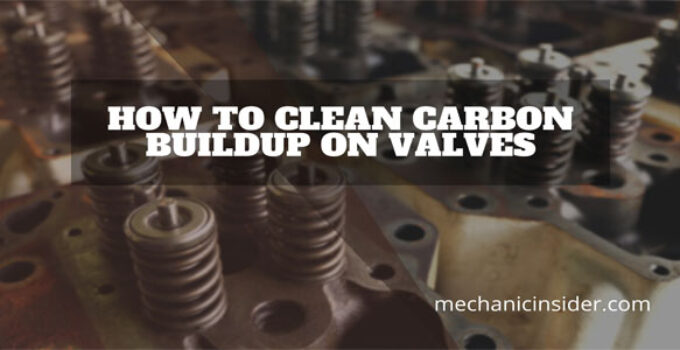Carbon buildup on valves has been a headache for many, we legit find that true. Poor fuel economy, struggling starting, barely smooth running and what not! Loads of questions are hitting our door asking how do I get rid of carbon buildup in my engine? Okay, so here we are! With a complete step by step solution and a thorough discussion, you’ll get rid of the carbons bothering your sweetheart in no time. Let’s get started.
Due to PCV and EGR, the engine develops carbon buildups. This article will tell you about cleaning the intake valves for a longer lifetime and better performance.
What is carbon buildup?
Carbon buildup is the black coating or dirt on your engine components that won’t come off easily. It happens because of the burning fuel inside the combustion chamber.
Nowadays upgraded, turbocharged, and downsized engines are high efficiency. But these changes are also the culprit of carbon deposits.
SigNs of carbon buildup
If you are interested to know how to remove carbon buildup in diesel engines, then you must look at the carbon buildup on valvessymptoms , here are the signs:
- Power loss at high speed
- Less acceleration rate
- Incomplete combustion
- Cold stalling
- Rough driving experience
- Fall of fuel efficiency
- Lethargic speed of engine judder
How to clean carbon buildup on valves
Removing carbon deposits from the valves is very important for the sustainability of your engine. So, here is the way that can help you to clean the valves:
Unhooking spark plug
Start by unhooking the spark plug wire to remove engine components.
Removing all the components
Detach all the components like the equipped batteries, mufflers, mufflers guard to avoid blocking the way to the cylinder.
Removing cylinder head
Make a rough outline of the cylinder head on cardboard to avoid confusion. After that look for the bolt location and punch holes for each of them.
Take off the cylinder head bolts and place them in the corresponding holes. That’s how to prepare the cylinder head for lifting it.
Lifting the cylinder head
Then check if the cylinder head is getting stuck while lifting. If it does, then use a nylon-faced hammer to strike it on the side.
Don’t detach the cylinder head completely with full force. Just loosen up so that the lifting process will be easier.
Prepare the valves for cleaning
For removing each valve, you have to turn the crankshaft. Use a valve removing tool to avoid mistakes. Take off the valves with a little push for the cleaning session.
Scrap off the carbon buildup
After detaching the valves, start the scrapping procedure. For that, gently scrap the visible carbon buildup off with the help of a wire made of brass.
Dissolve with a cleaner
What will dissolve carbon buildup? The answer is a strong cleaner. So, take the appropriate cleaner on a jar for soaking.
Dip the valves into the cleaning solution. Keep it in for 20 minutes. Then wipe off the dissolved dirt from the valve.
You’ll find a good engine carbon cleaner spray online. Check the valves before installing all the parts.
Choosing the cleaner
Do you want to know what is the best carbon cleaner? The answer is, it has to clean all the buildup without harming the plastic and aluminum components.
Don’t use the fuel injector cleaner for cleaning direct valves. Because it can only remove the buildup from the indirect valves.
Unlike the fuel injector cleaner carb cleaner can clean both direct and indirect engine valves. Consider all these to choose the bestcarbon cleaner for intake valves.
Re-attaching the valves
You will need a 3 inches PVC pipe, clamp, and vaseline or grease. Start by putting the vaseline on the longer side of the valve and insert it under the cylinder head.
Put the spring head on the top keeping the valve head in the middle. Then place the thinner side up and thicker side down in the center of the cap.
Use vaseline and set the cap on the top of that spring keeping it aligned. Place the PVC pipe on the top of that cap.
Lastly, place the clamp head on that pipe and the bottom part will be touching the valve. Squeeze the handle for creating the compression for the valve to go in completely.
When the spring goes down try to push the pin down with the help of a pick. In the end, release the clamp.
Table for the step-by-step guideline for cleaning valves
To make things easy for you, here are the main steps summarized in a table:
| no. | STEPS |
|---|---|
| 01 | Remove the valves from the cylinder head |
| 02 | Use a brass wire to scrap it gently |
| 03 | Dissolve the valves in the cleaning agent for 15 to 20 minutes |
| 04 | Wipe the dirt off with a cloth |
| 05 | Reassemble the valve on that cylinder head |
Steps of cleaning Carbon buildup on valves using a drilling machine
Do you want to know how to remove carbon build on intake valves in some other ways? Then you can use a drill machine too. Here is the guideline:
Step 01
Firstly you have to remove those valves from the cylinder head for doing this procedure.
Step 02
Then take off the drill bid from the machine and place the intake valve into the drilling machine.
Step 03
Take a razor blade and move it lightly around the valve to scrap off some of the buildups.
Step 04
After that, take a scotch bride and wrap it around the valve. Keep in on the downside as most of the dirt will be there.
Step 05
Then for the 2nd part of cleaning, use a less aggressive 2500 sandpaper. Hold the sandpaper around the valves keeping the drill on. Wipe off all the buildup gently without putting pressure.
Step 06
Use some metal polish on a pad for the last step to get rid of all the carbon coating.
Final verdict
Carbon deposits are modern engines is nothing new. Upgraded features don’t change the fact of having an excessive buildup of carbon.
The carbon buildup in engine can shorten the duration of service. For the betterment of your engine, always clean up the valves before it’s too late.



